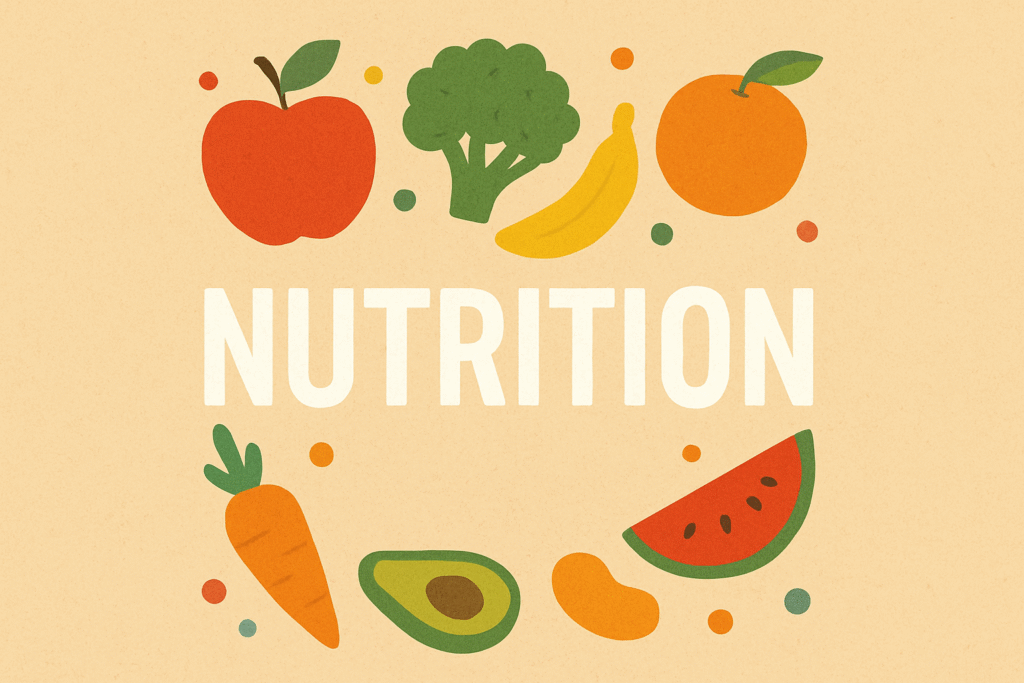📝 Definition
Nutrition is the process by which living organisms obtain and use food to grow, repair their bodies, and get energy.
📘 Nutrition: Types
1. Autotrophic Nutrition
- Definition: Nutrition in which organisms make their own food from simple substances like water, carbon dioxide, and sunlight.
- Example: Plants, algae.
- Process: Photosynthesis (plants use sunlight to make glucose).
2. Heterotrophic Nutrition
- Definition: Nutrition in which organisms cannot make their own food and depend on other organisms for nutrition.
- Examples: Humans, animals, fungi.
- Types of Heterotrophic Nutrition:
- Holozoic: Eating solid food (Humans, lions)
- Saprophytic: Feeding on dead organic matter (Mushrooms)
- Parasitic: Feeding on a living host (Tapeworms)
📘 Types Nutrients
A. Macronutrients
- Nutrients required in large amounts for energy, growth, and repair.
- Examples and Functions:
- Carbohydrates → Main source of energy (Rice, wheat, potatoes)
- Proteins → Growth and repair of body (Eggs, pulses, meat)
- Fats → Energy storage, insulation, protection (Butter, oils, nuts)
- Water → Transport, chemical reactions, temperature regulation
B. Micronutrients
- Nutrients required in small amounts for proper body functioning.
- Examples and Functions:
- Vitamins → Regulate body processes
- Vitamin A → Vision (Carrots)
- Vitamin D → Bone health (Sunlight, fish oil)
- Vitamin C → Immunity (Citrus fruits)
- Minerals → Support structure and functions
- Calcium → Bones and teeth (Milk)
- Iron → Hemoglobin formation (Spinach)
- Iodine → Thyroid hormone (Iodized salt)
- Vitamins → Regulate body processes
🔑 Quick Memorizing Tips
- Types of Nutrition: “Auto makes, Hetero takes” → Plants make food, animals take food.
- Macronutrients: Think “CPFW” → Carbs, Protein, Fats, Water
- Micronutrients: Think “VIM” → Vitamins, Iron, Minerals
📘 Questions on Nutrition
🟢 Very Short Answer (1 mark)
- Define autotrophic nutrition.
- Define heterotrophic nutrition.
- Name one example of saprophytic nutrition.
- Give one example of a carbohydrate-rich food.
- Name one mineral required for strong bones.
🟡 Short Answer (2–3 marks)
- List the two main types of nutrition.
- Give two differences between autotrophic and heterotrophic nutrition.
- Name four macronutrients and one function of each.
- Name two micronutrients and their function.
- Why is water considered a macronutrient?
🔴 Long Answer (4–5 marks)
- Explain the different types of heterotrophic nutrition with examples.
- Describe the role of carbohydrates, proteins, and fats in the human body.
- What are micronutrients? Give examples and their importance.
- Explain why a balanced diet should include both macro and micronutrients.
- Describe autotrophic nutrition and give an example of how plants produce their own food?
📘 Answers on Nutrition
🟢 Very Short Answer (1 mark)
- Autotrophic nutrition: Nutrition in which organisms make their own food from simple substances like water, carbon dioxide, and sunlight.
- Heterotrophic nutrition: Nutrition in which organisms cannot make their own food and depend on other organisms for nutrition.
- Saprophytic nutrition example: Mushroom (feeds on dead organic matter).
- Carbohydrate-rich food: Rice, wheat, potatoes.
- Mineral for strong bones: Calcium (found in milk, cheese).
🟡 Short Answer (2–3 marks)
- Two main types of nutrition: Autotrophic and Heterotrophic.
- Differences between autotrophic and heterotrophic nutrition: Feature Autotrophic Heterotrophic Food source Makes own food Depends on others Example Plants Humans, animals
- Four macronutrients and functions:
- Two micronutrients and functions:
- Vitamin A: Vision (Carrots)
- Iron: Hemoglobin formation (Spinach)
- Why water is a macronutrient: Required in large amounts for body processes like digestion, transport, and temperature regulation.
🔴 Long Answer (4–5 marks)
- Types of Heterotrophic Nutrition:
- Holozoic: Eating solid food (Humans, lions)
- Saprophytic: Feeding on dead matter (Mushrooms)
- Parasitic: Feeding on a living host (Tapeworms)
- Role of Macronutrients:
- Carbohydrates: Main energy source.
- Proteins: Build and repair body tissues.
- Fats: Energy storage, insulation, protection.
- Micronutrients:
- Nutrients required in small amounts for proper body functioning.
- Examples:
- Vitamins → regulate body processes (Vitamin C: immunity)
- Minerals → support structure and body functions (Calcium: bones, Iron: blood)
- Balanced diet importance:
- Includes both macro and micronutrients in the right proportion.
- Ensures energy supply, growth, repair, and overall good health.
- Autotrophic nutrition explanation:
- Organisms make their own food from sunlight, water, and CO₂.
- Example: Plants perform photosynthesis to produce glucose and oxygen.
